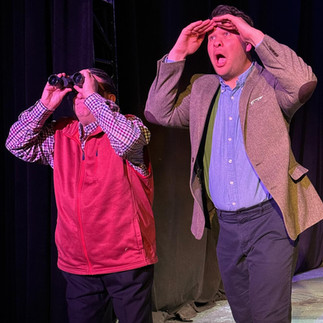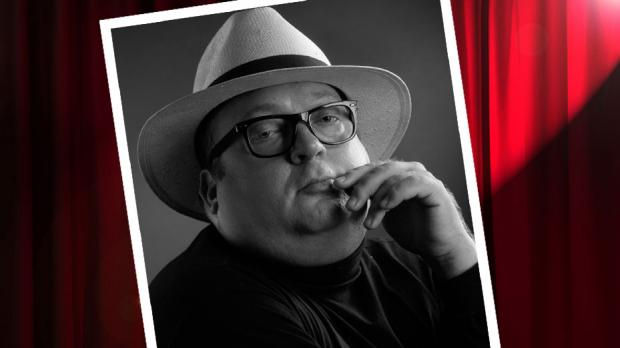Grumpy Old Men
- Anthony Chase

- Feb 27, 2024
- 5 min read
Updated: Feb 28, 2024
Review by Anthony Chase

There are probably many wonderful musicals that you’ve never heard of. I am talking about shows that begin life at places like the Goodspeed Opera House in Connecticut or Ogunquit Playhouse in Maine, never to be seen again.
It’s also true that perfectly lovely shows sometimes make it to Broadway, only to die a fast death. I thought Honeymoon in Vegas was a good musical. Ditto for Ground Hog Day and Chaplin. Still, these shows don’t get much respect.
Sometimes the fact that a show never makes it to Broadway has nothing to do with quality. It can be a question of timing or financing, or just bad luck. And sometimes these shows enjoy a wonderful later life at small professional theaters, community theaters, and schools across the country.
O’Connell & Company currently has one of those lost shows on offer. It’s the musical version of the 1993 Warner Bros. movie, Grumpy Old Men, and it’s crowd-pleasingly adorable.
Grumpy Old Men tells the story of next-door neighbors John Gustafson and Max Goldman, played by Jack Lemmon and Walter Matthau in the film, and here played by Michael Starzynski and Michael J. Galante. They hate each other and are engaged in a feud of insults and practical jokes going back decades. A new complication emerges when beautiful Ariel Truax, played by Ann-Margret in the film and by Anne DeFazio here, moves into the house across the street. Both men are smitten.
Despite its bad luck getting produced on Broadway, the show was developed with the highest aspirations. Its first table read in 2007 featured Broadway megastars George Hearn and Len Cariou as John and Max. Adrienne Barbeau was Ariel. Charles Durning played Grandpa, Garrett Morris was Chuck, and Vicki Lewis was IRS agent Snyder.
The creators -- book writer Dan Remmes, composer Neil Berg, and lyricist Nick Meglin -- made significant changes to the film scenario. The practical jokes of the film are gone. The secondary love story between Gustafson’s daughter and Goldman’s son is streamlined and featured more prominently. An IRS agent, played by Buck Henry in the film, is now a woman, a reversal that facilitates the resolution of the plot. Chuck, the owner of the general store is given a relative, Punky, who is new in town and deployed to bring the threads of the plot together.
I heard the score for the very first time at O’Connell & Company. It’s delightful. I was entirely charmed by the opening number, “Wabasha,” a parody of the happy villager numbers that open so many old-fashioned musicals from Fiddler on the Roof, to Brigadoon, to Hello Dolly! to Once on this Island. In this case, the citizens of Wabasha, Minnesota let us know how much they love their freezing town.
“We drive a while, to shop in style, ‘cause Amazon is hard to get. Slow in-ter-net in Wabasha.”
Yes, Wabasha is a sleepy mid-western town, but it’s presented through the lens of an urbane South Park-like sensibility. That aesthetic is heightened by a marvelously playful set by David Butler.
Butler creates a cartoon-like space with an entirely painted set, complimented by numerous matching two-dimensional painted props and furnishings. These include such comic flourishes as a snowmobile, groceries, a television fish tank, and a nude male sculpture. The ingenious design, simple yet clever, gives the show a handmade feel appropriate to the small-town setting, but also an urbane sophistication that advances its humor.
Some might object that not all the humor is sophisticated. The sexual preoccupation of John’s father, Grandpa Gustafson, is arguably adolescent. His wanton horniness and lack of filter is, believe it or not, even bigger than in the film. It gets its own musical number. Indeed, things get quite raunchy from time to time.
While Grandpa’s startling antics inspired giddy juvenile giggles from me, others might be shocked. I don’t, typically, care for “trigger warnings,” but on this occasion, and at this venue with its notably senior audience, I wonder if a little heads-up that there will be some comically crude material might give folks license to lighten up and go with the flow.
That wouldn’t add too much time to O’Connell & Company’s notoriously expansive curtain speeches. We are already told about upcoming shows; cellphone etiquette; cast changes; raffles; fifty-fifty splits; concessions; support from foundations, government, and people like us; the location of the rest rooms; the location of the fire exits; printer errors; and the weather. Then we’re thanked for supporting theater in Western New York and for choosing O’Connell & Company. I think they could quickly add that “If the f-bomb sends you into a tizzy, you might want to clutch your pearls, because that’s tame compared to what you are about to hear.”
On the other hand, if they can’t take a joke….
The production has been directed by Steve Vaughan and choreographed by Terri Filips Vaughan with wit and invention. The tone they strike is of a professional production masquerading as community theater. The dances are smart but never too ambitious. The acting is never overwrought. Nobody unleashes a purely legit voice. The silly yet soulful story skips along in its happy pace. Good triumphs. Evil is defeated.
Vaughan’s work is assisted by the casting of Starzynski and Galante. They are wonderful as the lovably irascible old men. Each has an excellent sense of comedy and sentimentality. Anne DeFazio confidently makes the requisite impression of irresistibility as free-spirited Ariel.
The production uses a pre-recorded click track, which on this pseudo amateur occasion seems somehow apt and allows for un-amplified voices, even among the younger cast members. Every word is distinct in a show where a great deal of the comedy is embedded in the lyrics. Nathanial Higgins is the music director.
Two cast members who have legit voices, but tone them down to pleasing musical comedy belts, are Christopher Wagner who plays Jacob Goldman and Sára Kovácsi who plays Melanie Norton. They use their vocal prowess to nail their duets, giving strong performances as the secondary romantic couple.
Pamela Rose Mangus chews up the scenery in the role of evil Sandra Snyder of the IRS. The same goes for John Kreuzer, who is all but unrecognizable as scandalous Grandpa Gustafson.
On the night I saw the show, Gail Golden went on for ailing Mary Kate O’Connell in the role of Punky Olander and did an amazing job after just one rehearsal. She was off-book and used her natural flair for comedy to make the part her own.
The costume designer for the show is Elaine Heckler. Light is by Jay Marks, and the prop designer is Matt Mogensen.
Grumpy Old Men is a highly satisfying evening of musical comedy. O’Connell &
Company is giving it both the respect and the irreverence it deserves.






















